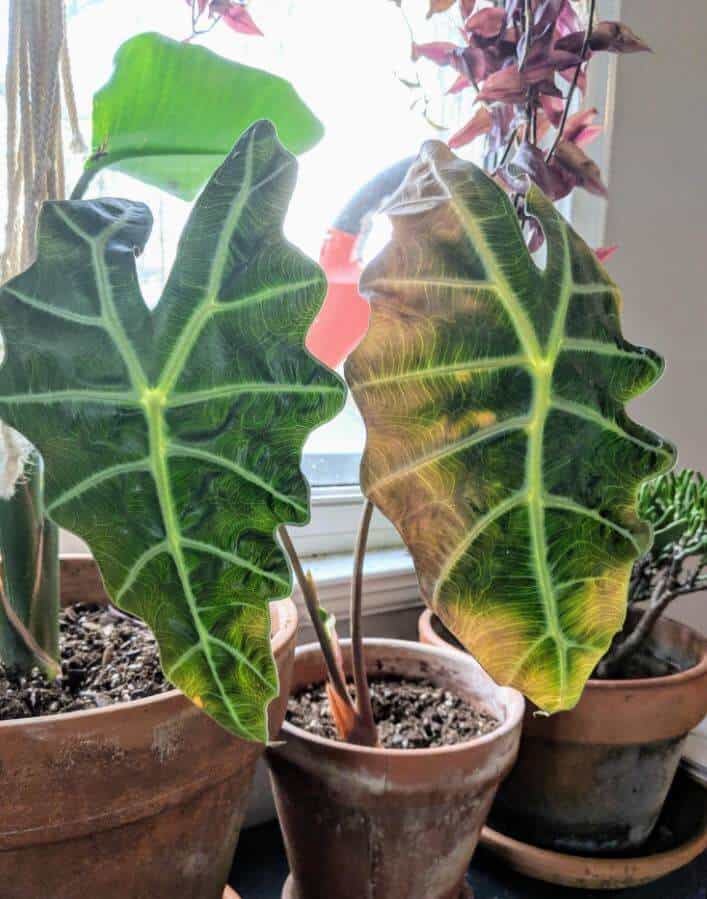Last Updated on July 20, 2023 by a Friendly Gardener
An often difficult plant to cultivate, the African Mask plant is an Alocasia species belonging to the Araceae family. It is a native of the South Pacific tropical areas. Its unusual foliage accounts for its name as the leaves somewhat resemble the carved African masks used for ceremonial purposes. Leaves boast a dark green almost blackish hue decorated with pale silvery-green veins and can grow to almost two feet in length. This plant’s stems are round and meaty, emerging from rhizomes. The stems can grow from two to four feet in height.
For all their beauty, however, these plants can be difficult to grow and a bit fussy despite ideal growing conditions. Let’s consider some common problems that you may run into, the longer you cultivate the African Mask plant.
Common African Mask Plant Problems
Yellowing Leaves
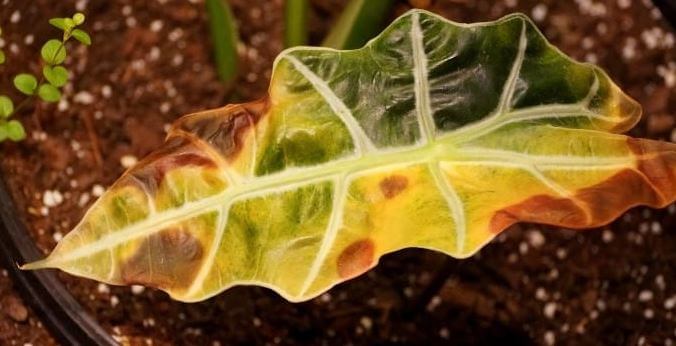
When this plant’s beautiful foliage begins to yellow this usually indicates a watering issue. This alocasia prefers a soil bed that is consistently moist. Soil beds should neither be dried out nor soggy and waterlogged.
What to do
If you tend to over or underwater your houseplants, consider investing in a moisture meter. Also, make it a point to water more often but in small amounts.
Foliage Turning Black
Your African mask plant can develop black leaves for several reasons. It may just be the foliage’s natural color as these leaves are a deep dark green that almost appears black. If, however, this dark hue is accompanied by other symptoms such as a brittle crispy, or soggy texture, your plant is in distress. Common causes are moisture, humidity, or environmental temperature issues.
What to do
The African Mask plant needs consistently moist soil and a constantly warm temperature. Keep this plant away from sources of drafts like vents, windows, or heating and air conditioning units. To increase humidity, use a space humidifier or a pebble tray. Create a pebble tray by filling a tray with pretty stones and then filling it with water. Your plant’s container can then be set on top of the tray however without it coming into contact with the water.
Brown Spots on Leaves
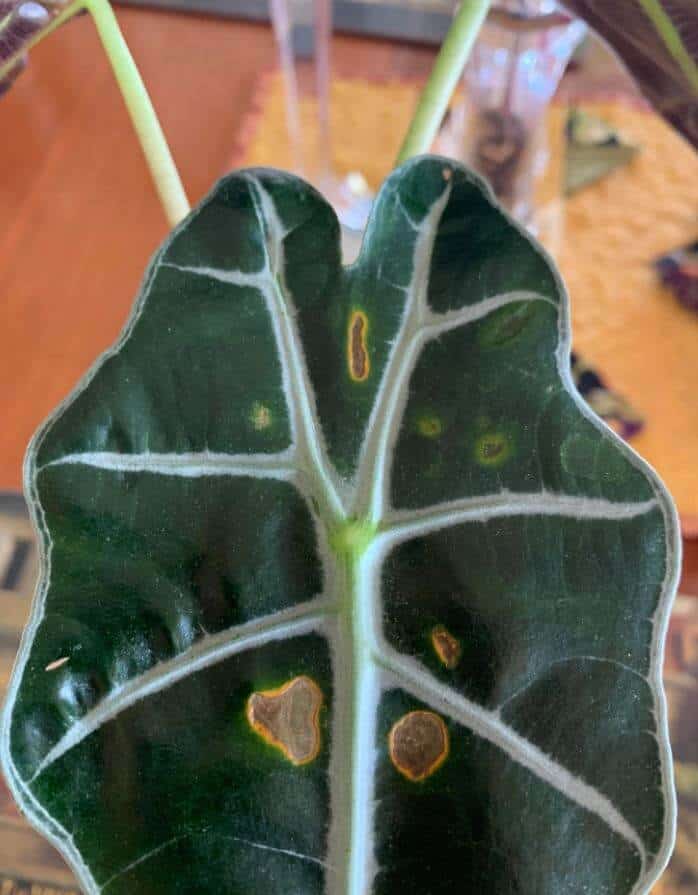
The development of brown spots on foliage is often caused by fluctuations in the environmental temperatures, although, pest infestations, diseases, improper lighting, and excess fertilizer can also cause spotting.
What to do
Keep your African Mask plant in a spot where the temperatures never fall below 60°F and where your plant will receive generous amounts of bright but indirect sunlight. If you note signs of a pest infestation, you should intervene immediately. Try using insecticidal soap or an organic pesticide like neem oil.
If brown spots appear to be small and are numerous, or if they appear as pustules, your plant may be infected with rust. Neem oil is appropriate because it is also an organic fungicide. Good air circulation can aid in preventing fungal infections.
African Mask Plant Leaves Curling
When African Mask plant leaves curl it can indicate several problems such as underwatering, extreme environmental temperatures, excessive fertilization, direct sunlight exposure, or low humidity. If there are no other accompanying symptoms, you have caught the problem early and should have no problem remedying the situation. Often plants will curl their leaves to contrast losing moisture. This is typical in cases of underwatering, low humidity, direct sunlight exposure, and extreme temperatures that adversely affect moisture retention.
What to do
It’s important to identify the cause. Check the soil moisture for underwatering. To check for low humidity, use a humidity meter as this is the only way to ascertain humidity levels. If you suspect overfertilization, interrupt feeding your plant for a while and if you suspect salt buildup in the soil, flush out the soil to eliminate the buildup. For temperature extremes, move your plant to a spot with a constant room temperature and with direct sunlight, move your plant away from direct sunlight.
African Mask Plant Dying
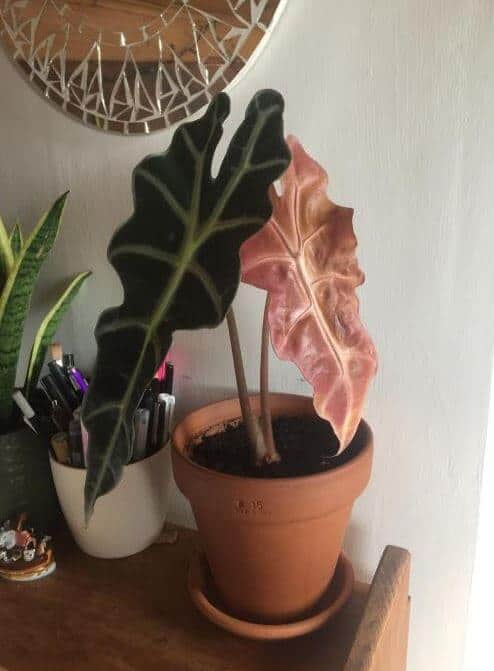
There are a variety of reasons that your African Mask plant may be dying. The most common reason is improper watering which is usually overwatering. Direct sunlight and fluctuating environmental temperatures can also be lethal for this plant.
Improper Watering
Too little or too much water can cause the African Mask plant to die. Underwatering will cause foliage to dry out while overwatering will turn foliage soft and yellow. To determine what is the cause, remove your plant from its container and carefully examine the soil. If the soil is dry and powdery in texture, you are underwatering. If the soil is soggy and waterlogged, you have been overwatering.
What to do
In the case of overwatering, you need to remove roots that are infected with root rot. Replant your plant in fresh soil and reduce watering significantly. This should stimulate new growth. In cases of underwatering, you need to water daily but only in small amounts to prevent shock. Invest in a moisture meter to prevent repeating errors in watering in the future.
Low Environmental Temperatures
Cold environments can be lethal for the African Mask plant, as their natural habitat is warm and humid. Cool drafts can also affect your plant adversely.
What to do
Move your plant to a new spot that is warmer and free of drafts.
Excessive Sunlight Exposure
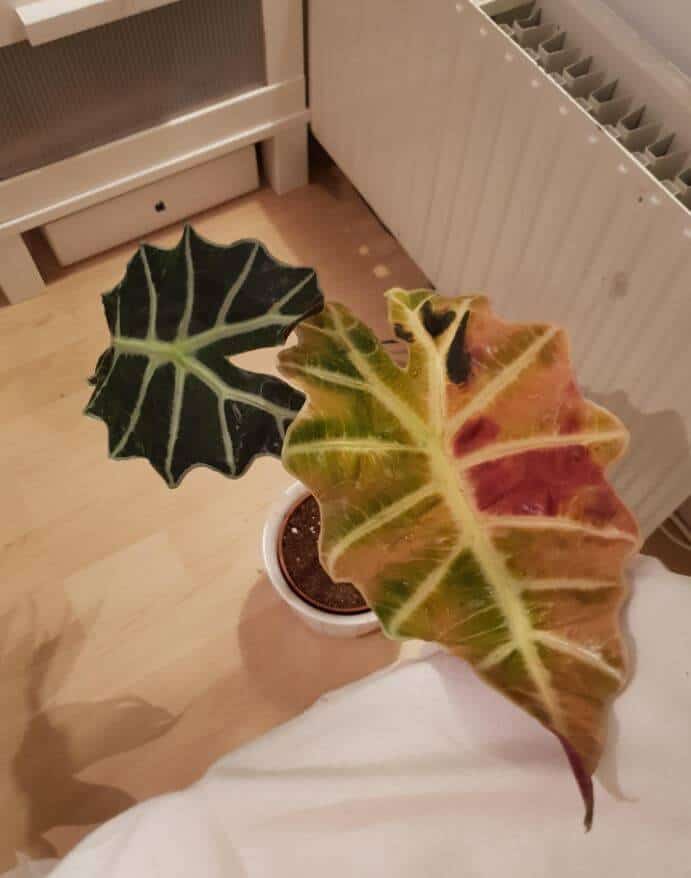
Alocasia that receives too much light may show scorched patches on foliage. Alocasias like bright light as long as it is indirect. In cooler seasons they can manage with a small amount of direct sunlight, but in warmer seasons, direct sunlight is to be avoided at all costs. When sunlight is harsh, it will burn leaves. Once scorching appears, it cannot be reversed. Damaged leaves can be removed.
What to do
Move your plant to a spot with indirect bright light.
Inadequate Humidity
If your plant’s leaves develop brown edges and tips, a lack of humidity is probably to blame. It is unlikely that typical indoor humidity can replicate tropical conditions.
What to do
If you cannot or do not want to place your plant in a steamy bathroom or kitchen, you can acquire a space humidifier or make a pebble tray. You can also opt to shower your plant with low water pressure although this is not a permanent or lasting solution.
Pest Infestations

Pest infestations may be less common than other problems you encounter. But a severe pest infestation can spell the end of your plant. Most pests that afflict houseplants are sap suckers like spider mites, scale, thrips, aphids, or mealybugs. Leaves may turn yellow and drop. Pests are particularly fond of hiding on the undersides of leaves or at stem joints.
What to do
Examine your plants weekly. If you find evidence of pests, isolate the plant so the infestation doesn’t spread to other plants. Prune-infested or severely damaged leaves. Shower your plant with a mild jet spray to remove pests and then treat your plant with the application of an insecticidal soap, citronella, or neem oil.

